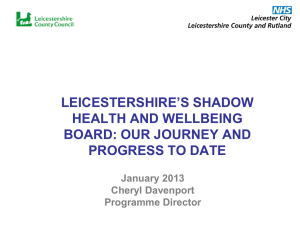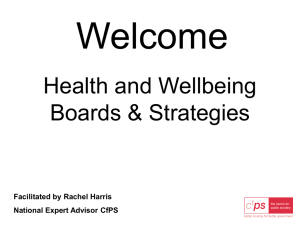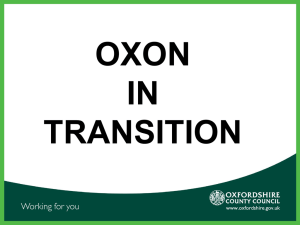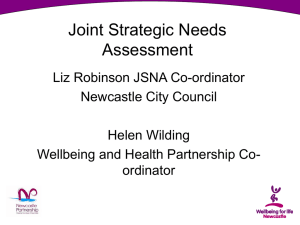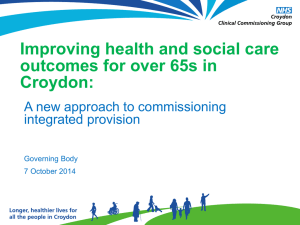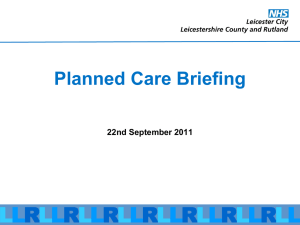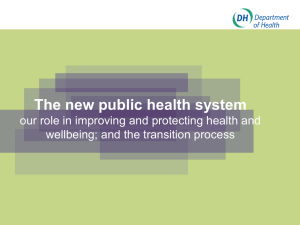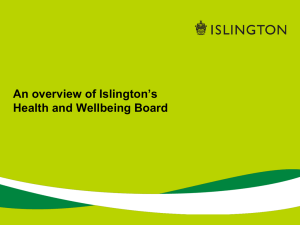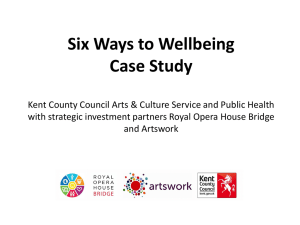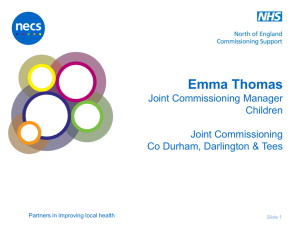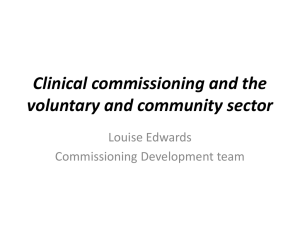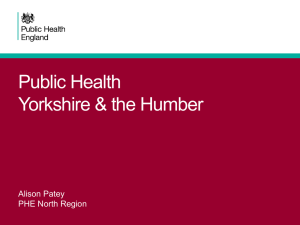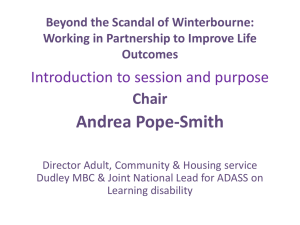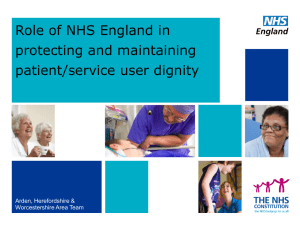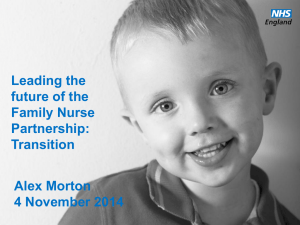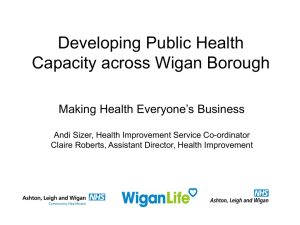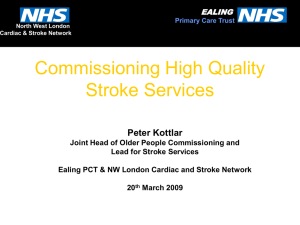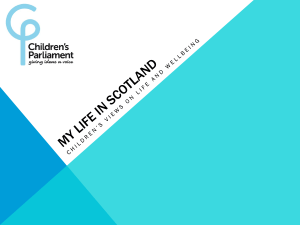Leicestershire Health and Wellbeing Board
advertisement
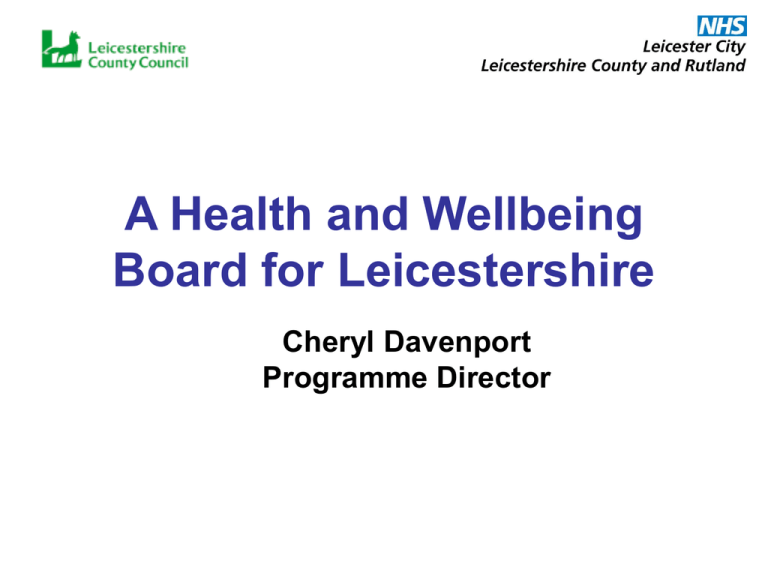
A Health and Wellbeing Board for Leicestershire Cheryl Davenport Programme Director Why are we establishing a Health and Wellbeing Board? • Included in the NHS White Paper ‘Equity and Excellence’ Liberating the NHS (July 2010) • Health and Social Care Bill (January 2011) makes the establishment of a Health and Wellbeing Board mandatory for each upper tier authority • Leicestershire is an early implementer What will the Health and Wellbeing Board do? Primary purpose is to:• Promote integration and partnership working between the NHS, Social Care, Public Health and other local services; and • Improve local democratic accountability. How will the Board achieve its purpose? • Identify needs and priorities across Leicestershire’s population, and ensure commissioning and delivery plans reflect the findings of our Joint Strategic Needs Assessment • Prepare and publish a Joint Health and Wellbeing Strategy • Communicate and engage with local people about how they can achieve the best possible quality of life • Have oversight of public sector resources, where appropriate. What does being an early implementer mean? • Working with other early implementer councils nationally and the DH, sharing good practice and ideas • Have the Shadow Board in place by April 2011 • We see this as a priority so we can: – Keep the focus of our collective attention on the task of improving health and well being outcomes during transition; and – Maintain momentum on important developments already in progress What is the difference between the Shadow and Statutory Boards? • Shadow Board is an advisory body to the County Council’s Cabinet, NHS LCR Trust Board and GP Commissioning Consortia • Statutory Board will be in place once legislation is passed, expected to be April 2013, and will be a Committee of the County Council with executive powers Who is on the Shadow Board? • The Cabinet Lead Member for Health • The Cabinet Lead Member for Adults and Communities • The Cabinet Lead Member for Children and Young People’s Services • At least one representative of each of the GP Consortia within the local authority area • The Director of Public Health • The Director of Adults and Communities • The Director of the Children and Young People’s Services Who is on the Shadow Board? (cont.) • LINk representation - 2 places (to replace with Local Health Watch representation, when established) • The Chief Executive of NHS LCR (the local Primary Care Trust)* • Local Medical Committee representation – 1 place • District Council representation – 2 places.** *This place could be allocated to a representative of the National Commissioning Board when this is established and their role is more defined. This is for further consideration in due course. ** Representation to be sought from Districts, after local elections in May 2011 Why are some organisations not represented? • Membership essentially follows statutory membership • Focus on small core group of commissioning leaders and democratic accountability • Structures beneath the board will ensure engagement and influence from a wide range of other organisations, such as providers, (including voluntary and community sector), professional advisors, and other stakeholders What are the implications of the new board for existing groups? • The health and wellbeing board will be one of the new commissioning hubs in the Leicestershire Together partnership during its Shadow period • In 2013 it will become a statutory committee of the Local Authority, which will mark a clear change in its position within partnership arrangements Diagram showing the Shadow Board and its position within the LT Partnership The changes mean new forms of governance within the partnership • Moving from soft ‘direction of travel partnerships’ to ‘hard’ decision making partnerships • Small number of Boards • Commissioners only on Boards • Support groups to include stakeholders • There will be overlaps Leicestershire Together Structure and Roles How will stakeholders engage with the Board, once it is in place? • Key platform will be the Strategy and Monitoring Groups beneath the Board which will inform commissioning decisions and support and deliver services. • These groups will call upon users, providers, commissioners, professional advisors communities and other stakeholders to ensure that the Board’s recommendations are wellinformed and that services are successfully designed and delivered. What is the process for establishing the Board? • One of six elements of work governed by the Joint Change Programme Board operating between the PCT, LCC and GP Consortia • Sub group established to co-ordinate implementation of the Health and Wellbeing Board • Terms of Reference to be approved by Cabinet (April 5) and PCT Trust Board (April 14) • Board will meet in public, at least quarterly How are stakeholders being engaged in the process? • Stakeholder mapping has taken place and we have considered the implications for existing groups and partnerships • A comprehensive stakeholder engagement plan is underway, (officers, staff, council members, professional groups, partnership groups, user/patient groups, NHS Trusts, LINks, Voluntary Sector, other agencies • Core products: presentation, briefing note, frequently asked questions and media materials How will the Board enhance local progress to date? • We are moving into a new phase of our partnerships in Leicestershire – Taking elements of joint commissioning into a more systematic approach, with clinical leadership – Using our strong foundation of partnership working – Moving from transitional arrangements to shaping the “end state” of the new system – Taking our collective learning to scope new opportunities (e.g. total place into community budgets) How will the Board enhance local progress to date? (cont) • The Board should improve accountability, governance, resource allocation and delivery across partners in the new commissioning system, with a focus on how we collectively deliver outcomes for local people • The commissioning partnership envisaged on this Board will design a specific performance and delivery framework to assure their work, reflecting partnership changes affecting the NHS, the local authority and other partners. What are the Next Steps? • Ongoing communication and engagement with stakeholders • Preparatory workshop for members of the Health and Wellbeing Board, mid-April • First meeting of the Board, late April • Stakeholder workshop, mid- May • Continue our work as part of the early implementer programme, including sharing our best practice with others Contact Details Cheryl Davenport Programme Director NHS Leicestershire County & Rutland/ Leicestershire County Council cheryl.davenport@lcr.nhs.uk 0116 295 7546 (office) 07770 281 610 (mobile)

